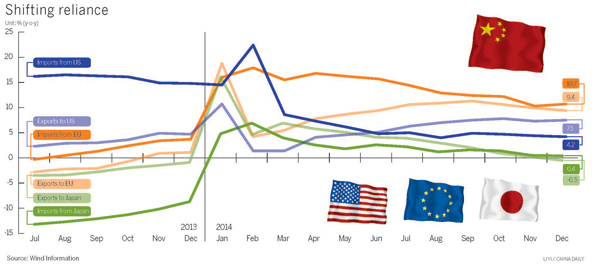
Experts say developed markets offer little comfort to Chinese exporters
Developed markets, the erstwhile pillars of China's foreign trade, may no longer be that central to the nation's long-term growth plans as emerging markets are shaping up as better alternatives, industry experts said on Tuesday.
With several European nations and Japan grappling with issues like high unemployment and slow economic growth, many Chinese companies are shipping more goods and deploying additional resources in emerging markets to maintain sustainable trade growth.
Zheng Yuesheng, spokesman for the General Administration of Customs, said China's trade with emerging markets including the Association of Southeast Asian Nations, Africa, Russia and India, amounted to 2.95 trillion yuan ($475 billion) in 2014, representing year-on-year growth of 7.1 percent, 4.3 percent, 5.6 percent and 6.8 percent, respectively.
During the same period, trade with Japan declined by 1 percent, while trade with the European Union and the United States grew by 8.9 percent and 5.4 percent respectively. The EU, the United States, ASEAN and Japan were the top four trading partners of China in 2014.
Eager to increase their export volume in the world market and avoid the long-term negative effects of the global financial crisis, many emerging countries such as Ghana, Sri Lanka and Indonesia have shifted their focus to China from their traditional trading partners like the US and European countries.
"With many emerging countries eager to accelerate the pace of urbanization and industrialization, China's electro-mechanical and labor-intensive product exports registered steady growth in 2014," said Zheng.
Exports of seven categories of labor-intensive products including textiles, garments, footwear, furniture and plastics grew rapidly in the emerging markets, along with growth in construction machinery and manufacturing equipment shipments.
Xie Weiming, vice-president of the Hangzhou-based Zhejiang International Business Group Co, said that the company's exports encountered lots of turbulence last year.
"The growth rate for exports used to be 15 to 20 percent five or eight years ago, but not for 2014," he said.
The company's total revenue in 2013 was $5.4 billion, with exports accounting for $4.36 billion of the total. Xie said that the year-on-year growth rate for exports in 2014 might be around 5 percent.
"We started to tap emerging markets from 2010 onwards, after the global financial crisis developed in Western countries. The growth rate for exports doubled that year, but subsequently we found that we could not maintain the same pace," he said.
Xie said that though developed markets, especially the US, have already returned to normal growth rates, they have not benefited companies from China.
"As the Western markets recovered, labor-intensive industries in the Southeast Asian countries also developed. They took a large proportion of our market share," he said.
According to Xie, most of the low-end manufacturing industries in Zhejiang province have moved to the Southeast Asian countries because of lower labor and material costs.
Guangdong Marshell Electric Vehicle Co Ltd, a designer and manufacturer of electric vehicles based in Zhaoqing, Guangdong province, is another company that is looking at emerging markets for growth. The company plans to export more small-sized electric vehicles to Southeast Asia and India this year. Sales of the company's products in the overseas market grew rapidly in 2014, according to Shu Wen, general manager of Marshell's sales department.
"Demand for Chinese-made electric vehicles is growing rapidly in emerging markets," said Shu, adding that overseas sales account for more than half of its total business.
